#Class of 1886
Explore tagged Tumblr posts
Text
"The awful bunching of hard examinations at the end of the first term of Senior year is one of the characteristics of our course of study as at present arranged."
--Princetonian, December 7, 1885
3 notes
·
View notes
Text

#I uh found some numbers for seasons 1-6#then ran more numbers for season seveb and eight#there are#ahem#or at least according to a reddid post#1886 minutes#like the show’s runtime#now i may be wrong#because i quickly fid this math between classes but#thats like#31.433 hours#which means that it would take me#1.31 days to watch the whole show#NOW#since Ive finished season one#‘twill only take me#a measly 1633 minutes#or#simply 27.217 hours#which is a bit over a full day#all in all#VERY doable#i can do this#🫡#only days worth of watching and a whole show’s worth of heartbreak#also i can’t believe i did alk that math#yeesh#voltron legendary defender#voltron
9 notes
·
View notes
Text
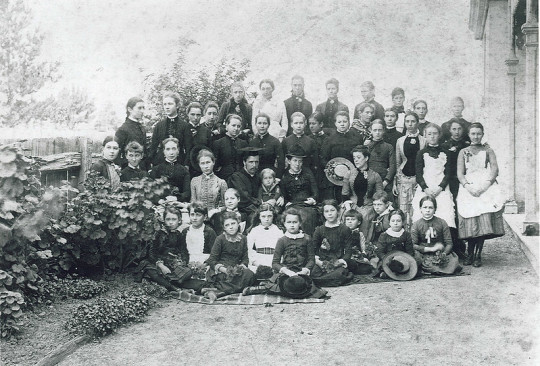
flickr
3 notes
·
View notes
Text


Leyendecker in 1895 (left) and with his lover, Charles Beach (right)
Joseph Christian Leyendecker was born in Montabaur, Germany, to a family of Netherlandic extraction, on March 23, 1874. The family immigrated to the United States in 1882, and settled in Chicago. From early childhood, Leyendecker drew images on any available surface, a tendency that his parents encouraged. As they were unable to afford private art lessons for their son, he was apprenticed at fifteen to a Chicago engraver, with whom he began his career by designing advertisements and book illustrations. During these years, Leyendecker also took night classes at the Art Institute of Chicago. By the time he was nineteen, he showed a mature technical mastery of the illustrator's art and, with his younger brother Francis X. Leyendecker (1877–1924), he traveled to Paris to study at the Académie Julien. The brothers returned to Chicago in 1898 and established a studio there. Both soon gained numerous commissions for magazine and advertisement illustrations, and in 1899, J. C. Leyendecker produced his first cover for The Saturday Evening Post, one of the leading mainstream American publications. Leyendecker's association with the magazine continued for the next four decades. With his holiday covers for the magazine, he virtually created the popular image of Santa Claus and the New Year's baby that Americans know today.


Leyendecker's 1912 New Year's baby (left) and 1923 Santa Claus (right)
Suddenly in great demand, the Leyendecker brothers moved to New York in 1900. Their work, characterized by what might best be called a discreet male homoeroticism, typically portrayed handsome young men, particularly athletes, soldiers, sailors, and muscular working men, as heroic figures, recalling the classical ideals of the French Academy and the sinuous lines of Art Nouveau. By 1914, J. C. Leyendecker had accrued enough wealth to build an estate in New Rochelle, New York, where he lived with his brother, his sister Augusta, and his lover Charles Beach (1886–1952). Leyendecker met Beach in 1903, when the young model from Cleveland first posed for him. The artist was impressed not only with Beach's handsome face and physique, but also with his ability to hold poses for extended lengths of time. Their relationship lasted until Leyendecker's death. Over the next thirty years, Beach's image as the "Arrow Collar Man," as well as Leyendecker's other representations of him, became one of the most widely circulated visual icons in mainstream American culture. In this capacity, Beach became the symbol of American prosperity, sophistication, manliness, and style.


Beach was the main model for the "Arrow Collar Man," the advertising figure of the Arrow Collars and Shirts Company and an icon of urbane American masculinity
For forty-nine years, Beach functioned as Leyendecker's model, lover, cook, and business manager. The household was extremely careful in maintaining a strict, even secretive, privacy. Although Beach's features were much in the public's gaze, few actual photographs of him or the Leyendeckers are to be found. Beach, presumably at Leyendecker's instruction, burned virtually all correspondence and many art works after the artist's death. The last years of J. C. Leyendecker's life were overshadowed by financial concerns, as he had spent as lavishly as he earned at the height of his career. By the 1940s, the major magazines increasingly supplanted artist's cover illustrations with photographs. As a result, Beach and Augusta sold many of Leyendecker's art works, which now bring hundreds of thousands of dollars at auction, for a pittance. Leyendecker died at his home in New Rochelle on July 25, 1951. Beach followed him in death within months. (Full article)
#j. c. leyendecker#jc leyendecker#f. x. leyendecker#leyendecker#arrow collar man#history#gay history#lgbt history#lgbtq history#art history#gay#mlm#lgbt#lgbtq#lgbtqia#art#male art#men in art
433 notes
·
View notes
Text
A Class Analysis of the Crown Villains

Analyzing all of the EN-released Villains from who would be the most to least wealthy in 1890s Victorian England.
A/N: This is just for fun! These characters/stories are not that deep, and I don’t want them to be! I just find it fun and silly to think through what this world would actually look like in history, and maybe you do too! 😊 Spoilers for pretty much every villain on the EN server, so read at your own risk! Also I am not a historian or economist, just a gal with a computer, so take all of this with a grain of salt.
Also, I’m assuming that Ikémen Villains takes place sometime in the 1890s in London, England—the tail end of Queen Victoria’s rule. This estimated time frame is based mostly on Harry’s love of Arthur Conan Doyle and passing mentions of when “he has a new novel coming out.” Doyle was a prolific writer and wrote for a long time, but I wanted to keep the time period specific enough to really think through what the economics would be like.
Wealthiest - Jude Jazza
Originally I was going to put the villains who belong to the gentry (Elbert and William and ... Victor??? Maybe?? haha) at the top of the list, but the more I thought it through, the more it became clear that in order for Jude to realistically carry out some of the actions in his route (which I haven’t finished!) or various story events/collection events, he would need to be so fucking rich. Like stupid wealthy. Like not quite at Jeff Bezos level of wealth, but pretty up there.
And baby started from the bottom now he’s here, okay! The fact that Jude grew up in abject poverty then became a successful CEO of a trading company originally struck me as one of the more unrealistic things in the game (which I do not care about, he’s still daddy), but the more I looked into it, the more I got on board with it. The writers were smart to add a rich benefactor to his backstory, because in 1890s London, that was probably the only way for a poor kid from the slums to receive an education. Wealth disparity was bad in the 1890s, and people were mad about it! Jude’s hatred of the rich and powerful is in keeping with working class (and even some middle class) attitudes at the time. And with the rapid development and expansion of the Port of London (from the completion of the Royal Victoria Dock in 1855 to the Port of Tilbury in 1886), trading was the business to be in at the time. So it’s not impossible that Jude could have just lucked out in a few key ways and worked extremely hard to get to where he is (although he would still probably be considered a unicorn in this time period).
As for Raven Co.’s annual profit: who knows. I’m guessing it’s in the billions in today’s money. I’m unsure what Jude’s salary would be, he is explicitly characterized in his route as a fair boss who pays his workers a living wage, but he’s also like randomly really generous with like Ellis or Kate (i.e. giving Ellis a blank check for Xmas, giving Kate more than enough money to get a dress, etc.) so he’s probably taking home plenty. And considering how smart Jude is, he’s probably pretty savvy about saving and investing his money. He also makes a lot of deals and has a lot of involvement overseas, so I wouldn’t be surprised if he has bank accounts in several countries. The man is committed to building his rocket, okay! I’d say his annual income is in the hundred millions of dollars (in today’s money). But his net worth is probably in the billions.
Lord Elbert Greetia
Okay, now on to our first landed-gentry boy: Lord Elbert. Lord Elbert is most likely the wealthiest member of Crown in terms of generational wealth, with William coming in a close second.
Elbert is a member of the landed gentry or “peerage” and uses the title of “Lord,” which he inherited from his father. Being in this class means that he not only has significant wealth (in literal pounds and assets), but it also means that he has a rock-solid social standing and owns land. Land ownership is a big deal here because it means that Lord Elbert has the power to control anyone who might be living/working on property that he owns. And I’m not just talking servants/staff at his estate, I’m talking residents of any townships or villages on the likely acres and acres of land that he's in control of. So he has a passive income via taxing residents and laborers on his land(s)... forever! Being in this class also makes his wealth a lot more stable and immutable than say, Jude, who is a great businessman but whose income and assets are at the mercy of the market/demand.
Elbert’s character in the game is very stoic (until Kate shows up!), and he has deep trauma from his childhood home, so he doesn’t seem to exercise a ton of the privileges that would be available to him in terms of controlling the people who live on his properties. But, if we’re talking the 1890s here, he would probably have entire villages or even small towns under his economic purview. I think of him as a Mr. Darcy type, probably bringing in about £10,000 a year, or a little over £1.5 million/$2 million in today’s money. This combined with the cost of all of his assets or “beautiful things” that he compulsively collects (artwork, fine furniture, jewels, real estate, etc.) means I’d estimate his net worth to be about $70-100 million in today’s money.
Lord William Rex
I’m only putting William after Elbert because I do think Elbert has more non-cash assets, simply from the nature of his curse which causes him to be greedy. But let’s be clear: Lord William is also loaded. He, like Elbert, is a member of the peerage of the time and owns lots of land/real estate. He probably receives a pretty substantial passive income from all of his properties like Elbert.
I do think there’s one key difference between them: I have a feeling that William would either redistribute some of the income that he gets from any taxed residents/workers on his properties or lower their taxes—he just seems like the type to be about that. So that’s another reason why I think Elbert might have a higher net worth. Still, we find out that William paid for the construction of a hospital in his route, and for a man to do that in the 1890s, he’d have to be pretty freaking rich. I’d say that his net worth is probably somewhere between $50-100 million in today’s money.
Victor???
Big question mark around Victor! I’m putting him here just because he is so connected to the Queen, and unless we learn something different from his route, I’m pretty sure that means he’s at least upper class, if not a (former) member of the gentry/peerage. Or perhaps comes from a wealthier family. He also receives a salary and lodging from the Queen (as do all the members of Crown I think) so he’s certainly getting all of his needs met. He’s also the oldest member of Crown, which just makes me assume he’s had more time to accrue savings. But couldn’t tell you what his net worth is even if you held a gun to my head, this is all just vibes haha.
Liam Evans
Liam grew up comfortably upper class, basically wealthy despite not being a member of the landed gentry. His father owns an estate, or at least did when Liam was a child, and had staff and servants. Because of his mental illness and disfigurement, Liam’s father probably relied entirely on family money after a certain point.
As an adult, and considering he is a successful and popular leading actor at a major theater in London at the time, Liam is doing well for himself! He is now much better off than his father! Good riddance! Actors at the major theaters at the time were typically paid anywhere between 2-25 pounds per week, and Liam was likely on the upper end of that spectrum. Let’s say he takes home 20 pounds a week, which in today’s money would be about 3,200 pounds, or about 4,000 dollars. That’s 208,000 dollars a year before tax! Not bad at all! But, it’s worth noting, that at the time actors were definitely not seen as contributing members to society (especially women/actresses—they were essentially thrown into the same category as sex workers), so Liam’s social standing in the grand scheme of things is definitely lower as an actor than it was probably growing up in an upper-middle class house.
Ellis Twilight + Alfons Sylvatica
I’m throwing these two in here together because they are probably doing well for themselves, but only because they are attached to a super-rich person haha. Who knows what their salaries/wages are or what kind of deal they have with their respective sugar daddies (hehe) but suffice to say they don’t have to worry about money. Alfons is probably more irresponsible with his money, only because of his lifestyle, but even so he’s nowhere near as big of a spender as Elbert so it probably all ends up a wash. And I’m assuming that Jude pays Ellis pretty well because he loves him lol.
Harrison Gray
Okay, this one took some digging! Harry’s dad was a police officer, which in today’s world would mean that his family was pretty well-off and Harry had a comfortable upbringing. Not a member of the upper classes/gentry, but probably solidly middle class. This is also implied in the game, or at least Harry isn’t one of the characters that we know grew up poor.
But, it turns out, police officers weren’t paid super well in mid/late 1800s London! Harry’s dad would probably be on the better-paid side of the spectrum because he was a chief/high-ranking, but the police were a relatively new-ish phenomenon and weren’t considered “high-value” professionals. Harry’s dad likely only took home about 10 guineas a week, which in today’s money is about £1,400 or $1,700, so he was making about $88,000 a year in today’s money (before taxes). Which would be relatively comfortable for a single person today, but for a family in the 1800s would be pretty much living paycheck to paycheck with maybe a couple splurge purchases a year (like for Christmas or birthdays). So Harry’s family wasn’t anywhere near as poor as Jude or Alfons were growing up, but they likely lived quite modestly!
As an adult, Harry probably makes a healthy salary as an editor/proofreader. Publishing was booming in the 1890s, and writers were most often serialized in weekly publications, which meant a steady income for both writers and publishers. I’d say Harry is probably taking home a couple hundred pounds at the least per week, so something in the thousands of dollars in today’s terms. It’s unclear to me what the rules of living in Crown castle are. Like do they pay rent? I don’t think so? Let’s say they don’t, which means Harry gets to save/keep all his wages and only spends on personal stuff. He doesn’t seem like the biggest spender, if anything he reads as very sensible with money to me, haha. So he’s likely got a cozy little net worth building up but nothing crazy. Since wealth stratification is so extreme in this time period (the rich were very rich and the poor were very poor), Harry would probably be making enough to still be looked down on by the upper classes and enough to still be the object of contempt for the lower classes.
Poorest ? - Roger Barel
Doctors today are very well paid, but this was not the case in the late 1800s! Growing up, Roger’s dad probably had an annual salary of about 300-500 pounds a year, or roughly $45k-$80k in today’s money. Not a lot to live on for a whole family now, but this probably went further in the 1870s/80s when Roger was growing up. It’s implied that his family lived relatively comfortably, so I’m guessing that his dad had a good reputation and was sought after for his surgical expertise. He may have even gotten paid to teach in surgery ‘theatres’ of the time. (I haven’t read or looked much into Roger’s route so this might be wrong!)
I’m only ranking him last because he seems to not be formally employed haha. Since Roger is not a publicly practicing surgeon, he is relying on his income (?) and lodging from Crown for his day-to-day expenses. This could be any amount it seems, haha, depending on what he asks Victor/the Queen for. He doesn’t seem like a crazy spender, so he’s probably not complaining. I have no idea what his salary would be, though. It doesn’t seem like Crown bothers with all that, haha.
#ikemen villains#cybird ikemen#ikemen games#ikemen series#cybird otome#cybird#ikevil#ikevillains#ikemen villains william#ikemen villains ellis#ikemen villains jude#ikemen villians alfons#ikemen villians liam#ikemen villains victor#ikemen villains roger#ikemen villains elbert#ikemen villains harrison#william rex#elbert greetia#ikemen villains liam#liam evans#harrison gray#roger barel#jude jazza#ellis twilight#ikevil victor#alfons sylvatica#ikevil jude#ikevil alfons#ikevil william
291 notes
·
View notes
Text
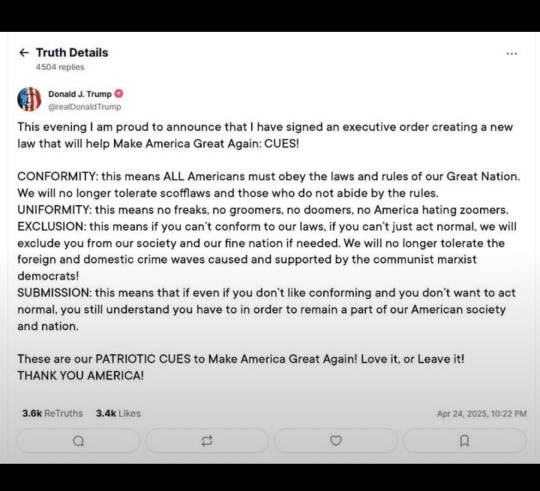
In the ancient times of the Roman republic, 2nd century AD, to celebrate Dionysus and Aphrodite, and to welcome spring becoming summer, Floralia, or the festival of Flora, is the earliest record of practicing mayday.
Throughout the centuries, all across Europe, many cultures have welcomed summer with mayday celebrations of their own. Although traditions vary from region to region, and have changed over time, the overall theme is similar, embracing the warmth and beauty of spring with bonfires, dancing, drinking, feasting and community.
As human civilization moved into the industrial age, a period that saw great prosperity for a few, and exploitation to the many, mayday took on a new persona.
In Paris, 1889 the International Workers Congress called for worldwide solidarity of the working class to demand the 8 hour workday.
In defiance of the robber barons, in the early days of the Gilded age, the United States observed its first participation of the labor movement celebrations of mayday in 1886, protesting for the 8 hour workday and for universal peace with a work stoppage, or general strike.
As you could imagine the so called masters of men, the titans of industry, the robber barons, the tech oligarchs, the hoarders of capital, considered this action of solidarity amongst the working class threatening and unacceptable. Throughout the years there had been much violence and turmoil surrounding the holiday. Mayday is still widely celebrated in Europe as an observation of the worker and the invaluable contribution they give to society through the sweat of their brow, their determination and grit.
Venez m’aider, or in short, m’aider, is the French phrase for, come and help me, or help me. In England in the 1920 the term mayday, an adaptation of m’aider, was adopted for the early air traffic controllers as a distress call, alerting pilots and crew of potential dangers. It has since been a general call for distress
This may 1st hold duel meanings and great significance. Both in the celebration and defence of the working class, and as a signal of dire warning.
The activist group 50501 is continuing their ongoing campaign against oppressive oligarchy, tyrannical rule, American and human rights, with demonstrations beginning May first, or Mayday.
En lieu of Trump’s proposal of CUES, let’s give him, and the fascist surrounding him, a social “cue”, showing our determination, strength and grit. The American people are that of immense resolve, fiery spirit, and insufferable defiance. Perhaps some have forgotten the stubbornness of Americans. Maybe they forgot our opposition to tyranny. it may have slipped some folks recollection of our insistence for freedom, for liberty, for our hard earned rights.
This is both a celebration of the people and a call for general distress to the world.
This Mayday, May 1st, take to the streets. No matter the size of your town or city. Protest oppression and autocracy together with your fellow countrymen (countrypeople) and show that fascism and totalitarianism will not be allowed in the United States of America. As one we are meek, together there is nothing that can stop the power of the American people. Together we stand, divided we fall.
For more information check out, www.fiftyfifty.one or www.maydaystrong.org
We must join in solidarity for liberty, to quote some orange, second rate reality tv personality, wannabe strongman, prick, “or we won’t have a country anymore”
May our nation endure such dark times…
🇺🇸
#trump is a threat to democracy#politics#traitor trump#donald trump#republicans#democracy#news#freedom#free speech#resist fight unite#resist#maga morons#american people#usa#protest#50501#no kings#impeach trump#stop trump#fuck trump#trump administration#tariffs#ukraine#us politics#we the people#maga#republican assholes#gop#gop hypocrisy#bernie sanders
60 notes
·
View notes
Text



This post translates directly to @musas-sideblog's about how Touchstarved ties with Victorian horror and implicit/metaphorical sex, and I couldn’t stop thinking about it, so here is a lengthy theory. Enjoy :)
Note 1: Victorian era authors used an unholy amount of ways to imply sexual feelings/acts etc, so I here I will include only the ones that are of interest. Note 2: I've highlighted the "most important" parts. Note 3: I'm not an expert at this, so please bear with me and feel free to correct me. Note 4: Do I need to add a TW? I think it's obvious-

Overview: What is Victorian Horror?
Victorian horror refers to the genre of horror literature, art, and culture that flourished during the Victorian era, roughly from the mid-19th century to the early 20th century, coinciding with Queen Victoria's reign from 1837 to 1901. This period was marked by a fascination with the macabre, the supernatural, and the dark aspects of human nature, reflecting the anxieties and societal changes of the time.
Key Themes and Characteristics
Supernatural Elements:
Ghosts and Spirits: Tales of haunted houses and spectral apparitions were central to Victorian horror. Charles Dickens's "A Christmas Carol" (1843) and Henry James's "The Turn of the Screw" (1898) are notable examples.
Monsters and the Gothic: The era's literature is filled with monstrous creations and gothic settings, such as in Mary Shelley's "Frankenstein" (1818), Bram Stoker's "Dracula" (1897), and Robert Louis Stevenson's "Strange Case of Dr Jekyll and Mr Hyde" (1886).
Science and the Unknown:
The Victorian period was a time of great scientific advancement, but also of fear about the implications of these discoveries. This is evident in works that explore the dangers of unchecked scientific experimentation, like "Frankenstein" and H.G. Wells's "The Island of Doctor Moreau" (1896).
Exploration of the Human Psyche:
Victorian horror often delved into the darker aspects of the human mind, including themes of duality, madness, and the hidden, sinister side of human nature. This is seen in "Dr Jekyll and Mr Hyde" and Edgar Allan Poe’s works, such as "The Tell-Tale Heart" (1843).
Social and Moral Anxieties:
The literature frequently reflected Victorian society's fears and anxieties, including issues related to sexuality, class, and the role of women. Gothic novels often contained subtexts about societal norms and the consequences of transgressing them.
Urban Fear and Isolation:
The rapid urbanisation of the Victorian era contributed to themes of isolation, alienation, and fear of the crowded yet lonely cityscape. This is evident in the settings of many horror stories, such as Arthur Machen's "The Great God Pan" (1894).
Sexual Content: Victorian literature is renowned for its strict moral codes and conservative views on sexuality. Explicit depictions of sexual activity were considered taboo and were subject to censorship. Consequently, authors developed subtle and nuanced methods to imply sexual scenes or themes.
Literary Techniques for Implying Sexual Scenes
✧ Symbolism and Imagery:
Sexuality was often conveyed through symbolic imagery. Objects, actions, or natural phenomena could serve as metaphors for sexual activity or desire. For example, in "Dracula" by Bram Stoker, blood and biting symbolise sexual penetration and the exchange of bodily fluids, infusing the act with a sense of forbidden desire and eroticism.
Clothing and Undress:
Gloves: In Victorian culture, gloves were highly symbolic. The act of a woman removing her gloves in the presence of a man, or a man assisting her in this act, could signify a moment of intimacy or vulnerability. Similarly, a man giving a woman his gloves could be a sign of affection or a deeper connection.
Hats and Bonnets:
Corsets
Objects and Personal Items:
Locks of Hair
Jewellery
Books and Letters
Touch and Physical Contact:
Kissing Hands
Hand-Holding
Food and Drink:
Wine: Sharing wine or a meal in an intimate setting often suggested a prelude to deeper connection. Descriptions of characters drinking wine together in private could imply a romantic or sexual undertone.
Fruit: Certain fruits, like apples, grapes, or peaches, were laden with sexual symbolism. Eating or sharing fruit could represent temptation or indulgence. For instance, in Christina Rossetti’s poem "Goblin Market", the act of eating the goblin fruit is rich with sexual symbolism.
Flora and Fauna
Flowers and Gardens:
Roses: Roses were often used to symbolise love and passion. A red rose might suggest romantic or sexual attraction, while a wilted rose could imply lost innocence or sexual ruin.
Lilies: Lilies, especially white ones, represented purity but could also suggest a contrasting theme when associated with a fallen or tarnished character.
Garden Settings: Scenes set in secluded gardens or amongst lush, overgrown vegetation often hinted at secret or forbidden encounters. Descriptions of characters wandering through or tending to gardens could imply sexual exploration or awakening.
Flowers Blooming or Opening: The blooming of flowers often represented sexual awakening or the act of losing one's virginity.
Nature Imagery:
Rivers and Water: Flowing water and rivers often symbolised sexual desire and the act of lovemaking. For instance, in "Tess of the d'Urbervilles" by Thomas Hardy, Tess's encounter with Alec d'Urberville is often described with metaphors of nature and fluidity.
Storms and Weather: Storms, with their intense energy and sudden outbursts, were frequently used to symbolise sexual passion or climactic moments.
Birds and Beasts:
Animals, especially those that are wild or predatory, often symbolised primal sexual instincts and desires. The taming or interaction with these animals could imply a character’s grappling with their own sexuality.
Fire and Heat
✧ Phrases and Sayings
Euphemistic Language
Descriptive Phrasing
Dialogue and Confessions
Private Spaces:
Secluded or Dimly Lit Rooms: Scenes set in private, darkened rooms often suggested clandestine sexual encounters. The privacy of the setting allows authors to imply what could not be explicitly stated. In Wilkie Collins’s "The Woman in White", many key interactions happen in secluded spaces, hinting at secrets and hidden desires.
Dreams and Fantasies:
Dream Sequences:
Dreams and fantasies were used to explore a character’s subconscious desires and fears, often revealing their suppressed sexual longings. These sequences provided a socially acceptable way to delve into erotic themes.
Hallucinations and Madness:
Moments of madness or hallucination could serve as a metaphor for overwhelming passion or uncontrollable sexual desire. These states allowed characters to express forbidden feelings in a way that was metaphorically safe.
Physical Interactions and Horror
Touch and Proximity as Menace:
Unwanted or Forced Touch: In horror, touch that is typically a sign of affection or intimacy becomes a source of fear.
Physical Closeness in Horror Settings: Close proximity in dark, secluded places amplifies the sense of claustrophobia and vulnerability, turning what could be an intimate setting into one fraught with terror.
Undress and Exposure in Horror:
Loosening Corsets and Vulnerability: The act of undressing or loosening clothing, which can be a prelude to intimacy, in horror often leaves characters vulnerable to attack or exposure of their deepest fears.
Food and Consumption in Horror
Cannibalism and Vampirism:
Blood as Sexual and Vital Fluid: The act of consuming blood, as in vampirism, blends the themes of sustenance and sexual exchange. The vampire's bite becomes a metaphor for both sexual penetration and the transfer of life force.
Example: "Dracula" is a prime example where blood consumption is deeply eroticized, with Dracula’s victims often portrayed in a state of ecstatic submission as he drains their blood.
Food as a Lure: Food and feasting, typically symbols of pleasure and indulgence, in horror contexts can be used to lure victims into dangerous situations.
Example: In "Goblin Market" by Christina Rossetti, the goblins’ fruit is both irresistibly tempting and dangerous, representing a forbidden and potentially fatal indulgence.
Plot and Character Dynamics in Horror
Power and Domination:
Common Dynamics with a Dark Twist
Predators and Victims: Characters who prey on others are often literal monsters in horror, representing the loss of control or innocence.
Secrecy and Concealment:
Hidden Desires and Monstrous Revelations: Characters who conceal their true identities or desires often find these hidden aspects manifesting as monstrous or terrifying in horror narratives, suggesting that repression can lead to dire consequences.
Clandestine Meetings and Forbidden Encounters: Secret meetings and forbidden relationships, often tinged with sexual implications, add an element of danger and fear, suggesting that transgressing social norms leads to horror.
Common Themes in Victorian Horror
Duality and the Doppelgänger:
Theme: The concept of duality, where a character has a hidden, darker side, or encounters a double (doppelgänger), often symbolises the internal conflict between good and evil within individuals.
Connection: This theme reflects Victorian anxieties about identity, morality, and the consequences of repressing one’s darker impulses.
Gothic and Supernatural Elements:
Theme: Victorian horror is rich with Gothic elements such as haunted houses, dark landscapes, and supernatural beings. These elements create a sense of dread and evoke the mysteries of the unknown.
Connection: The Gothic setting often serves as a backdrop for exploring human fears, isolation, and the impact of the supernatural on everyday life.
Decay and Degeneration:
Theme: The fear of decay and degeneration, both physical and moral, is a recurring motif. This theme often examines the decline of individuals, families, or societies and the consequences of corruption and vice.
Connection: This theme mirrors Victorian concerns about the erosion of social and moral values amidst rapid industrial and social changes.
Madness and Psychological Horror:
Theme: The exploration of madness and psychological horror delves into the fragility of the human mind and the terror of losing one's sanity. This often includes hallucinations, obsessions, and the thin line between reality and delusion.
Connection: This theme resonates with Victorian fears of mental illness, the limitations of medical knowledge, and the impact of societal pressures on mental health.
Forbidden Knowledge and the Faustian Bargain:
Theme: The pursuit of forbidden knowledge and the resulting consequences is a central theme. Characters who seek power, immortality, or forbidden truths often pay a heavy price, reminiscent of the Faustian bargain.
Connection: This theme highlights Victorian anxieties about scientific progress, moral boundaries, and the potential hubris of human ambition.
The Uncanny and the Unknown:
Theme: The uncanny involves the strange and unfamiliar becoming eerily familiar, often unsettling the reader and characters. It blurs the lines between reality and the supernatural, invoking fear and discomfort.
Connection: This theme taps into Victorian fears of the unknown, the foreign, and the otherworldly, reflecting broader anxieties about social and cultural boundaries.
Death and the Afterlife:
Theme: Victorian horror frequently grapples with themes of death and the afterlife, exploring the fear of mortality, the possibility of an afterlife, and encounters with the dead or undead.
Connection: These themes reflect Victorian preoccupations with death, the spiritual realm, and the possibility of life beyond death, often intensified by the era's high mortality rates and interest in spiritualism.
Isolation and Alienation:
Theme: Isolation and alienation are prevalent themes, often highlighting characters who are physically or emotionally detached from society, leading to their vulnerability and descent into despair or madness.
Connection: This theme resonates with the Victorian experience of industrialization and urbanization, which often led to feelings of disconnection and loneliness.
Class and Social Anxiety:
Theme: Victorian horror often explores themes of class and social anxiety, including the fear of losing social status, the consequences of poverty, and the tension between different social classes.
Connection: This theme reflects the rigid class structures of Victorian society and the fears and tensions that arose from social mobility and economic disparity.
Moral Corruption and Hypocrisy:
Theme: Victorian horror frequently critiques the era’s moral standards and exposes the hypocrisy of societal norms. Characters who appear virtuous often harbor dark secrets or engage in morally dubious activities.
Connection: This theme mirrors the Victorian concern with appearances and the underlying tension between public propriety and private desires.
The Five Pillars of Victorian Horror & The Five Love Interests
The Supernatural and the Gothic (Ais)
Essence: Victorian horror often revolves around the supernatural, blending Gothic elements to evoke a sense of dread and otherworldly terror. This includes ghosts, vampires, haunted houses, and curses, which create an atmosphere where the boundaries between the natural and the supernatural blur.
Impact: The use of Gothic settings and supernatural phenomena provides a backdrop for exploring deeper themes of fear, mortality, and the unknown.
Psychological Depth and Madness (Vere)
Essence: Victorian horror delves into the complexities of the human mind, exploring themes of madness, obsession, and the psychological effects of fear and trauma. Characters often grapple with their sanity, facing inner demons as terrifying as any external threat.
Impact: This focus on psychological horror allows for a deeper exploration of character motivations and the impact of societal pressures.
Moral Corruption and the Double Life (Leander)
Essence: Themes of moral corruption and the duality of human nature are central to Victorian horror. Characters often lead double lives, presenting a veneer of respectability while concealing dark, sinful secrets. This tension between outward appearances and hidden truths reflects the era’s social hypocrisy and fear of scandal.
Impact: These themes critique Victorian society’s emphasis on propriety and the dangerous consequences of repressing one’s true nature. The idea of a double life or hidden self adds to the horror by suggesting that evil can reside within anyone, masked by a facade of normalcy.
Decay, Degeneration, and Disease (Kuras)
Essence: The themes of physical and moral decay, societal degeneration, and disease permeate Victorian horror. These motifs symbolise the fragility of human life and the inevitability of decline, reflecting the anxieties of a society grappling with rapid change and uncertain futures.
Impact: By focusing on decay and degeneration, Victorian horror underscores the transient nature of life and the ever-present threat of corruption and decline, whether through ageing, moral compromise, or societal breakdown.
Isolation and Alienation (Mhin)
Essence: Isolation and alienation are pervasive themes in Victorian horror, often depicted through characters who are physically or emotionally cut off from society. This separation heightens their vulnerability to external threats and internal fears.
Impact: Isolation serves to intensify the psychological tension and sense of dread, as characters confront their fears alone. It also reflects the era’s social and existential anxieties, including the fear of being disconnected or outcast from society.

Generally, I believe each LI connects with a pillair (as seen above). Perhaps by looking at the archetypes we could deduce propable endings and route elements.
Forgive me, for the following part is MESSY;
Ais
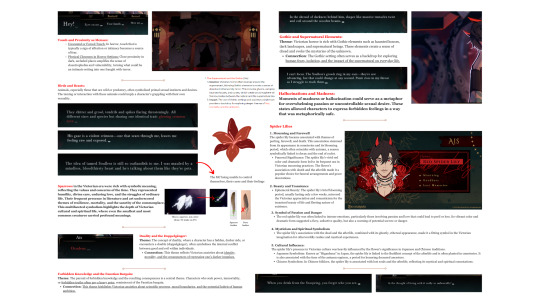
Vere
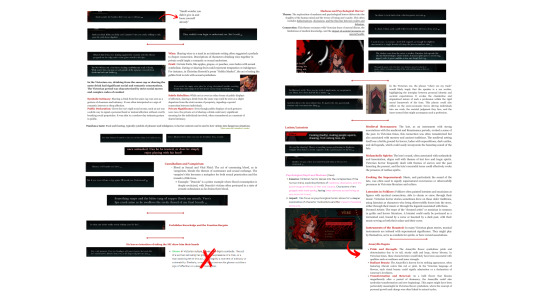
Leander
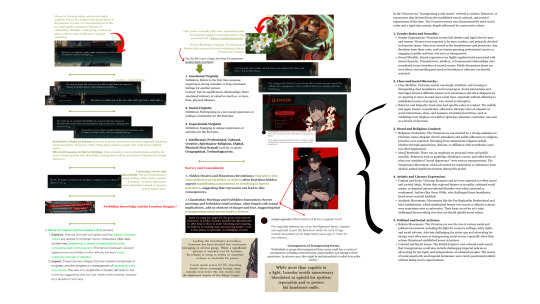
Kuras
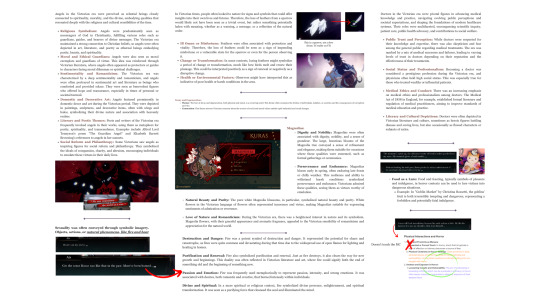
Mhin
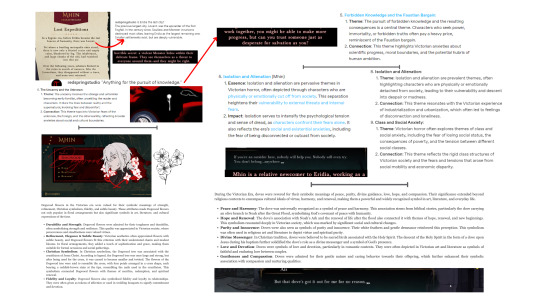

#THIS TOOK ME AGES#but it was worth it#vereletters#touchstarved theory#touchstarved theories#touchstarved ais theory#touchstarved vere theory#touchstarved kuras theory#touchstarved leander theory#touchstarved mhin theory#red spring studios#touchstarved#ts#touchstarved headcanons#touchstarved game#touchstarved oneshot#ais#ais headcanons#ais ts#ts ais#ais touchstarved#touchstarved ais#ais oneshot#vere#vere headcanons#vere ts#ts vere#vere touchstarved#touchstarved vere#vere oneshot
231 notes
·
View notes
Text

The Artist's Wife and his Setter Dog
Artist: Thomas Eakins (American, 1844–1916)
Date: c. 1884–1889
Medium: Oil on canvas
Collection: Metropolitan Museum of Art, New York City, NY, United States
Description
Eakins began this portrait shortly after his marriage in January 1884 to his former student, Susan Hannah Macdowell (1851–1938), a talented painter and photographer. The setting is his studio at 1330 Chestnut Street in Philadelphia, where the couple—and their dog, Harry—lived from 1884 to 1886. A photogravure of the painting from 1886 reveals a more robust woman, suggesting that Eakins reworked the portrait, amplifying the effect of the skylight’s illumination. The alterations may have reflected Eakins’s anguish over his controversial dismissal from the school of the Pennsylvania Academy of the Fine Arts, partly for removing the loincloth from a male model in a co-ed class.
#portrait#oil on canvas#interior#female#american culture#full length#american art#artwork#fine art#woman#seated#dog#chair#open book#rug#curtain#blue dress#chest#oil painting#thomas eakins#american painter#19th century painting#metropolitan museum of art
58 notes
·
View notes
Text
From the Seattle IWW, written by FW Noah in 2022: "The True History of May Day."
In the United States and many other countries, there are labor days that celebrate the working class contributions to the economy, the infrastructure, and the nation as a whole. While many of these holidays give great praise and pomp towards working class people, they often overlook the history that led up to the foundation of such celebrations, and what the foundations were really laid upon. Much of the early labor history is filled with great strife, conflict, death and destruction often directed towards working class individuals, who attempted to organize their lives in a way to break off the shackles of exploitation and capitalism as a whole. May Day began as a remembrance of the Haymarket Affair of 1886, when several anarchists who were supporting a protest for the 8 hour day in the city of Chicago were falsely accused by the police of detonating a bomb, and were executed as a result despite nationwide demands for their clemency. Since that day, every May the 1st became a day of celebrating the toil and contributions of workers in society and the struggle for better working class conditions, and uplifted the voices of those who were often marginalized or ignored by the upper classes. However, the United States of America has a different official Labor Day, established by the federal government in 1894. The change in date was intended to distract workers from the more radical origins of the holiday. This began a trend in the larger labor movement away from uniting the working class as one body with common interests and towards formalizing relations between a disadvantaged class and those with the power and wealth to decide the course of negotiations.
172 notes
·
View notes
Text

Tiger Tuesday: A tiger is one of several images on this cover of Princeton's Class of 1886 Bric-a-Brac, along with a short quote from the "Tiger Skyrocket," sometimes also called "three cheers and a tiger."
The entire Tiger Tuesday series
2 notes
·
View notes
Text
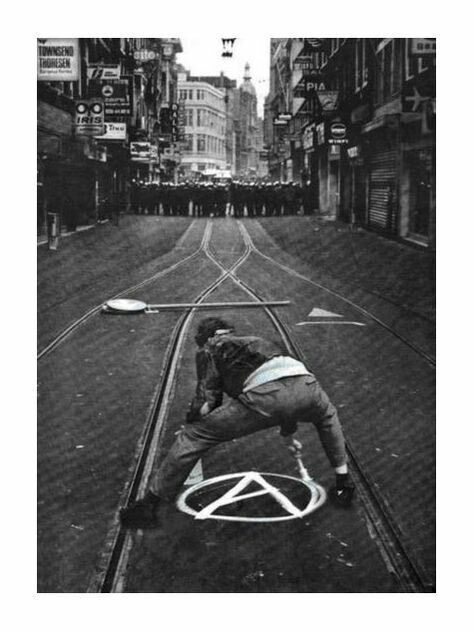
Photo of The Day
Dia Internacional dels Treballadors
El Dia Internacional dels Treballadors, el Primer de Maig, és la jornada reivindicativa del moviment obrer mundial.
Aquesta jornada de lluita pels drets dels treballadors fou establerta al congrés obrer socialista celebrat a París el 1889. Es decidí que, en homenatge als «Màrtirs de Chicago», treballadors anarquistes executats als Estats Units d'Amèrica (EUA) arran de la Revolta de Haymarket de 1886, l'1 de maig seria el dia de protesta i reclamacions obreres. En aquell moment, la gran reivindicació que s'establí fou la jornada de vuit hores. La vaga era l'instrument que es decidí d'emprar cada 1 de maig per forçar la patronal i els estats liberals a acceptar la jornada de vuit hores.
La campanya tingué molt d'èxit i, a poc a poc, prengué importància i es consolidà com a jornada de lluita al llarg del segle xx de tot el moviment obrer internacional, més enllà de les tendències i faccions ideològiques. Amb la conquesta de millores laborals i socials, el dia anà perdent càrrega reivindicativa per agafar un caire més festiu i de remembrança dels fets de Chicago de 1886. Actualment, gairebé a tots els països occidentals (Estats Units i Gran Bretanya en són excepcions notables) és un dia festiu.
______________________________________________________________
Langileen Nazioarteko Eguna edo Maiatzaren Lehena[1] langileen mugimenduaren nazioarteko jaieguna da.
II. Internazionalak, 1889an eta Parisen, aldarrikatu zuenetik Chicagoko martiriak omentzeko eta langileen eskubideen eskabidea egiteko eguna da, nahiz eta herrialde askok onartu ez. 1886ko maiatzaren 1ean Chicagon sindikalari anarkista batzuk greba bat hasi zuten zortzi orduko lanaldia eskatzeko.
______________________________________________________________
O Día Internacional dos Traballadores ou Día Internacional do Traballo ou Primeiro de Maio, é a festa por antonomasia do movemento obreiro mundial.
Por acordo do Congreso Obreiro Socialista da Segunda Internacional, celebrado en París en 1889, é unha xornada de loita reivindicativa e de homenaxe ós Mártires de Chicago, sindicalistas anarquistas, que foron axustizados nos Estados Unidos pola súa participación nas xornadas de loita pola consecución da xornada laboral de oito horas que tiveron a súa orixe na folga iniciada o 1 de maio de 1886 e o seu punto álxido tres días máis tarde, o 4 de maio, na Revolta de Haymarket en Chicago.
______________________________________________________________
El Día Internacional de los Trabajadores o Primero de Mayo es la conmemoración del movimiento obrero mundial.
Desde su establecimiento (aunque la consideración del día festivo fue en muchos casos tardía) por acuerdo del Congreso Obrero Socialista de la Segunda Internacional, celebrado en París en 1889, es una jornada de lucha reivindicativa y de homenaje a los Mártires de Chicago. Estos sindicalistas anarquistas fueron ejecutados en Estados Unidos por participar en las protestas de lucha por la consecución de la jornada laboral de ocho horas, que tuvo su origen en la huelga iniciada el 1 de mayo de 1886 y su punto álgido tres días más tarde, el 4 de mayo, en la Revuelta de Haymarket.
______________________________________________________________
International Workers' Day, also known as Labour Day in some countries and often referred to as May Day, is a celebration of workers and the working classes promoted by the international labour movement.and occurs every year on 1 May,or the first Monday in May.
The International Workers Congress held in Paris in 1889 established the Second International for labor, socialist, and Marxist parties. It adopted a resolution for a "great international demonstration" in support of working-class demands for the eight-hour day. The 1 May date was chosen by the American Federation of Labor to commemorate a general strike in the United States, which had begun on 1 May 1886 and culminated in the Haymarket affair four days later. The demonstration subsequently became a yearly event. The 1904 Sixth Conference of the Second International, called on "all Social Democratic Party organisations and trade unions of all countries to demonstrate energetically on the First of May for the legal establishment of the eight-hour day, for the class demands of the proletariat, and for universal peace"
International Workers' Day
#photo of the day#International Workers' Day#pho2art#black and white photo#black and white photography#photo on tumblr#vikipedia
17 notes
·
View notes
Text
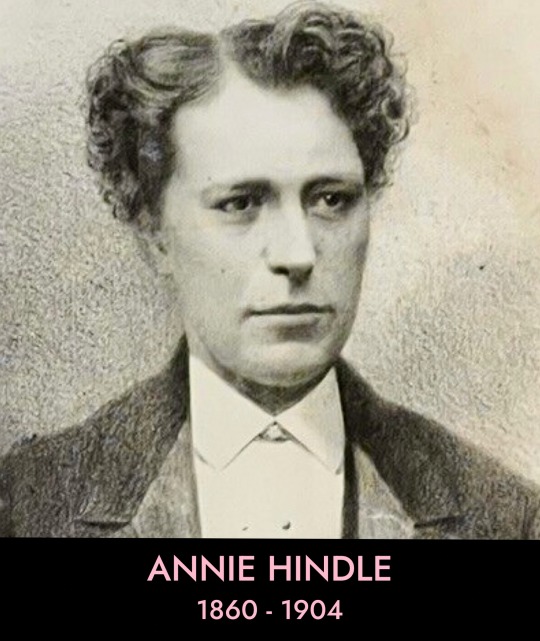
Annie Hindle was one of the first male impersonator in the United States. She was born in the 1840s in England. By the early 1860s she was performing in British music halls singing as both male and female characters - with quick costume changes in the wings between songs.
With her short clipped hair, a low alto voice and realistic costume, Hindle could transform herself into men from all walks of life, singing and comment on everything from courtship and marriage to class solidarity.
Hindle immigrated to New York City in 1868. She billed herself as:
“Miss Annie Hindle, serio-comic and the greatest male impersonator in the world”
Soon after arriving, Hindle married Charles Vivian, a ballad singer. But six months later they separated. There’s no record they ever got divorced. Hindle later said that Vivian was a heavy drinker with a hot temper and he beat her.
Annie received good reviews for her solo act in minstrel shows which led to steady bookings. One review for a performance in Galveston, Texas, said:
"Annie Hindle has proved a great success. As a male impersonator her sex is so concealed that one is apt to imagine that it is a man who is singing."
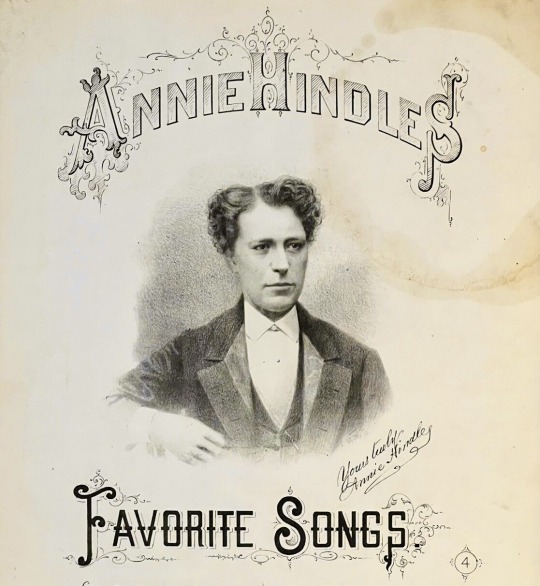
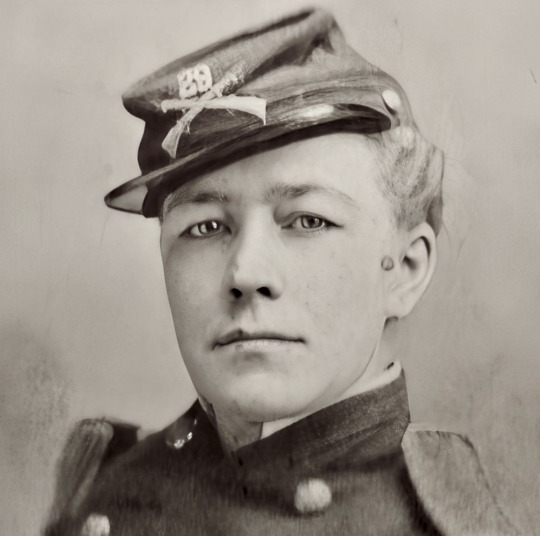
In 1870, Hindle performed at the Metropolitan Hall in Washington, D.C. Blanche Du Vere, a “jig” dancer was also on the bill. Records from that year show a marriages occurred between Blanche and “Charles” Hindle. There relationship only lasted a year but Blanche gained a new career when she began performing as a male impersonated under the name Blanche Selwyn.
In 1886, in Grand Rapids, Michigan, Hindle married her dresser Annie Ryan while on a tour through the mid-west. Hindle dressed as a man gave her name as Charles. Within days a reporter began hounding the couple, asking questions about the legitimacy of their relationship. His article soon appeared in the Grand Rapids newspaper.
Despite the scandal, Hindle’s career and marriage persevered. She and Ryan moved to a new town and Hindle got a new agent. They remained together for five years; until Ryan’s death in 1891. Newspapers reported that theatrical professionals attended Ryan’s funeral.
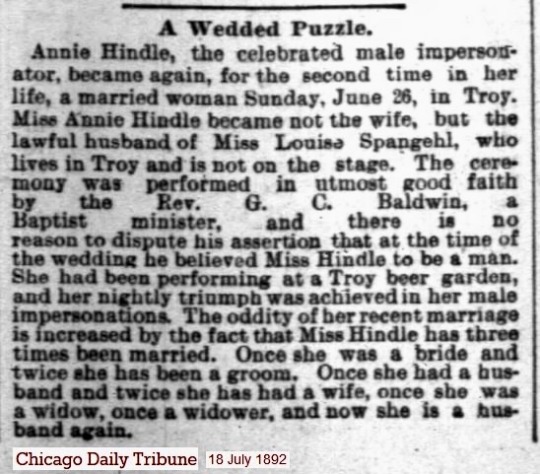
Handle went back on the road with her male impersonator act. Hindle met Louise Spangehl while performing on stage in Virginia. Their wedding was reported in The Pittsburgh Dispatch. The minister who performed the wedding thought Hindle was a man.
Hindle’s last known public performance was in 1904.
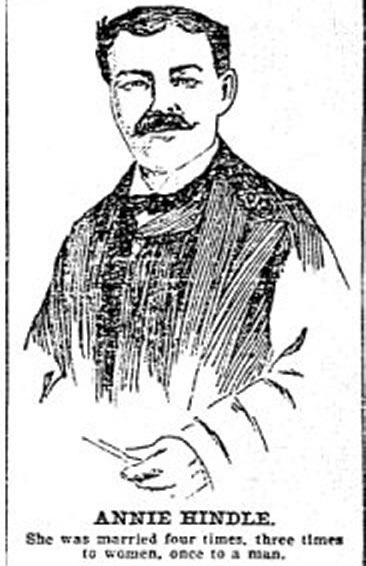
#gay icons#Annie hindle#male impersonator#drag king#same sex marriage#women loving women#stage performer
20 notes
·
View notes
Text
Research Deep Dive: Crossing the Elorn

One thing I love about doing research for my fantasy series, Kroashent, is coming across fascinating snippets of primary sources describing very specific historical events, often ignored by broad strokes history. A recent deep dive on a small region of France called "Plougastel" led to a series of 19th century descriptions of crossing the Elorn River. Located on a peninsula between the river and a larger body of water, the only "reliable" way to enter the region was across the river. (The following are translated from French):
"The very green shore of Elorn is full of bizarre rocks that affect the shape of ruins. The path rises in the middle of orchards and fields with fairly rich vegetation: it is here that the most fruits are harvested in the whole surrounding countryside, the cultivation of the strawberry above all is done on a large scale and nothing, it seems, is more curious, at the time of the season, than the long lines of [train] cars aligned along the road, waiting for their turn to pass. ”
Paul de Jaeghere (1886)

Kerhouan Train Station
“As the river is oriented to the west, in the direction of the gull [A passage leading to the Atlantic Ocean], when the sea is stormy to the west and southwest, the passage of the ferry is often impossible: the high easterly winds also produce a sufficiently violent surf to sometimes prevent docking and compromise the safety of the boats in the creek, which is 100 m long and 50 m wide. This creek serves as a shelter for the so-called Plougastel boats which exclusively provide a transport to the Harbor of Brest.”
Benjamin Girard (1889)
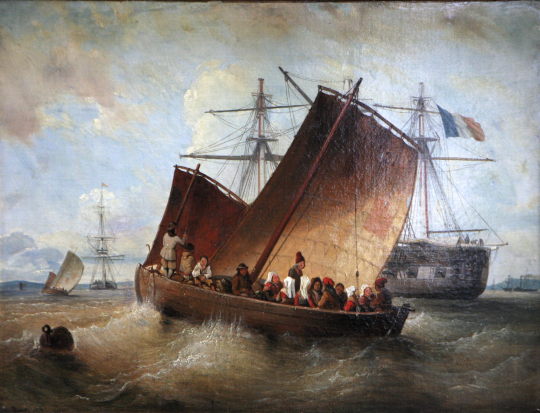
La barque de Plougastel (Ferdinand Perrot, 1808-1841)
In 1890, a bridge over the Elorn collapsed during the Pardon (A Breton Cultural procession and a whole other topic) of St. John. A hundred people fell into the water and 7 drowned. The June 27th edition of La Presse blames the disaster on poor organization, and praises the heroes who saved the majority of the victims. There's also something about a shark, but the newspaper clipping I found is hard to read.
"Left Kerhuon station, we arrive the banks of the Elorn and go into a tub to cross it. Women returning from the market, strong, flourishing, laughing, grab gigantic oars and have fun rowing by singing a song, while the boatmen, happy with this momentary rest, laugh at the provocative poses they take pulling back with the effort. They wear coiffes with curved wings, floating ribbons, colored belts and some short hoods. The sailors are capped with a red wool cap, similar to that of the convicts, strapped with a wide belt of the same tinted and dressed in a white or blue jacket lined with bone buttons"
Albert Clouard (1892)

(The Coiffe, traditional headdress of Plougastel)
Now, this is very interesting to me for a few reasons, because it really captures a moment in time, but also because of an interesting detail of the "red cap", which has an incredibly complex role in French culture and history. Tangent incoming.
In 1675, Western Brittany erupted in rebellion over a Stamp Tax, in an uprising called the "Red Cap Revolt", due to the red caps worn by the rebels. This iconic aesthetic became a symbol of French revolutionary zeal, especially during the 1790 Revolution (The Big One), where it became a symbol of working class revolution and to mock the wigs of the nobility and fancy hats of the clergy. (Brittany at the time had a reputation of being full of impoverished, working class peasants and was a major hotbed of the Revolution and Reign of Terror). The red cap was adopted as a symbol of citizenship and revolution. It appeared in protests, political cartoons and in the mass executions by guillotine. Interestingly, in 1792, Convicts were forbidden from wearing the hat. A red cap was even placed atop the spire of Strasbourg Cathedral to prevent its destruction in 1794!
Following the restoration of the French Monarchy in 1815, but remained an indelible part of French culture, even appearing as the symbol of the 2024 Paris Olympics!

(Image is from a Bande-Dessinee, but I can't seem to find which one to source...)
So I find it very interesting that in 1892, Mssr. Clouard associates the cap with "forçats" (Forced labour convicts). Its a fascinating bit of history nestled into a tiny snapshot of a guy crossing a river to a remote peninsula. Back to the river.
"The ferryman is there, who is waiting for me. A figure of old fisherman, twist and cooked under the beret. … By the modest sum of two sous, I embark, the old man lights his pipe and sails, and three minutes later, I am in front of the tiny port of Passage [de Saint-Jean], a real toy port with a miniature quay, terminal circled with iron, customs hut and, swinging on the waves, three or four fishermen's boats"
Tancrède Martel (1897)
I love some of the term "port-joujou" (Toy Port). Mssr. Martel is from Marseille, so I feel he is allowed to have a somewhat judgy, but cute take on this little river landing with 5 boats in it.
In 1907, a steam ferry came to town, to the dismay of the locals. The ferry was expensive and inconveniently timed, and drove all the local ferrymen out of business. When it wasn't in operation, people had to drive all the way up to a different crossing upriver, as they had to do in the middle ages!!! Its a great example of the conflict between the industrial age and traditional local customs, as the "progress" of industrialization actually inconvenienced everyone!
in 1930, a bridge was built, but the ferries returned during WWII when the fleeing German army blew up the bridge.
I hope you enjoyed this little deep dive into history with me. I find it fascinating that so much history can come out of a little crossing over a small river in a remote part of the world. The crossing at Plougastel offers us a glimpse of a community grappling with national identity and the march of industry. But it also shows us something special. Laughing women playing and singing on a river, writers from far off cities and locals on their daily commute sharing a brief moment of connection, and the men and women who connected these tiny points on the map.
#Plougastel#Brittany#France#French History#Bridges#history#Deep Dive#Learning with Val#History Hyperfixation#Connection#Elorn River
14 notes
·
View notes
Text
May Day protesters plan rallies against the Trump administration : NPR
On May Day, protesters are honing their message to decry what they say are attacks on the working class and immigrants. Organizers for the effort, called May Day Strong, say the administration and its billionaire allies pose a threat to labor rights, public services, and the safety of immigrants regardless of their legal status. Organizers have stated their opposition to violent forms of protest.
"This is a war on working people," organizers said on the May Day Strong events web page.
"They're defunding our schools, privatizing public services, attacking unions, and targeting immigrant families with fear and violence," they added. "We are reclaiming our power from corporate elites, and we will not be intimidated by Trump, Musk, or their billionaire backers.
They've ruled for too long.
"The U.S. does not officially observe the labor holiday, due to what historians say is an enduring resistance to working-class unity. Despite that resistance, America's working class has found ways to commemorate May Day since the 19th century.
The tradition began with a labor strike.
Why Americans protest on May 1
Before the 8-hour workday became standard, the organization now known as the American Federation of Labor planned a nationwide strike for May 1, 1886, to demand an 8-hour workday, as many workers were doing shifts twice that long.
The Chicago strike, known as the Haymarket Affair, turned violent when police clashed with civilians, and a bomb exploded. Although the bomb's intended target was unclear, four men connected to the protests were hanged for conspiracy to commit murder and became celebrated as the Haymarket Martyrs. The Pullman railroad strike also played a significant role in establishing May Day in the U.S. Workers from the Pullman Palace Car Company initiated a widespread work stoppage in May of 1894, prompting President Grover Cleveland to send federal troops to Chicago to break the strike.This set the stage for the long history of co-opting May Day.
Inspired by the Chicago workers, the international socialist movement gained traction, with activists spreading Marxist literature. In an effort to to detach May Day from labor movements, U.S. presidents have tried to redefine its significance. President Dwight D. Eisenhower made May 1 as "Law Day" — to recognize how the rule of law protects civil liberties, and Labor Day was moved to September.
During his first term, Trump echoed his predecessors by declaring May 1 "Loyalty Day," a time to celebrate the country's loyalty to individual liberties. Previous May Days during Trump's presidency saw similar protests and boycotts by immigrants and workers who railed against the Republicans' border wall plans and mass deportations efforts.
But the protests held across the U.S. in 2006, triggered by a bill to increase penalties for illegal immigration, might serve as a better comparison. Those March protests saw some 2 million demonstrators rally in 140 cities and 39 states.
What distinguishes Thursday's planned May Day protests is the scale of the movement, said Joseph McCartin, professor of labor history at Georgetown University.
With more than 1,000 events planned for May 1 in over 1,000 cities, according to organizers, McCartin said the nationwide protests stand to become the world's most widespread May Day on record.
"These are going to be protests that bring out a broader array of people and a broader array of places, and I think that's going to be historic, at least for that reason," he said.
#May day protests 2025#May day strong#Npr#May day strike#International Labour day#may 1st#workers rights#workers rise up#Fuck Trump
15 notes
·
View notes
Text
isn't it interesting how a ton of stuff on Jekyll and Hyde connects Mr Hyde to Jack the Ripper and says that Hyde is based on him?
The strange case of Dr Jekyll and Mr Hyde was published in 1886. Jack the Rippers killings were in 1888.
I can get how the two can be seen as similar(but really not much since they are very very different apart from the night stuff and being very brutal with the one(s) they killed. So two similarities that I can think of) but I don't get where the Mr Hyde being based on the Ripper came from.
Is there something I'm missing or is it just some weird thing everyone has kind of decided on? Even in my English literature class the teacher has said over and over how Hyde is based on Jack.
Any information I have missed that explains this would be appreciated. I'm confused. Might be wrong. I don't know anymore. This is just something that has been on my mind recently.
#Little bit of a rant#Ramble#the strange case of dr jekyll and mr hyde#dr jekyll and mr hyde#Jack the ripper#Idk#mr hyde#edward hyde#am i missing something
24 notes
·
View notes
Text






Milestone Monday
On this day, November 11 in 1887, four convicted anarchists, German-American businessman George Engel (b. 1836), German-American printer Adolph Fischer (b. 1858), and American journalists and activists Albert Parsons (b. 1848) and August Spies (b. 1855), were executed as a result of the Haymarket Affair, the aftermath of a bombing that took place at a labor demonstration on May 4, 1886, at Haymarket Square in Chicago. A fifth conspirator, Louis Lingg (b. 1864) committed suicide in his cell the day before his execution.
The bombing had left one person dead and several workers injured, and ensuing retaliatory gunfire by the police caused the deaths of seven police officers and at least four civilians, with dozens of others wounded. The incident was the climax of the social unrest among the working class in America known as the Great Upheaval.
Among supporters of the labor movement, the trial was widely believed to have been unfair, and even a serious miscarriage of justice. The progressive governor of Illinois John Peter Altgeld noted that the state "never discovered who it was that threw the bomb which killed the policeman, and the evidence does not show any connection whatsoever between the defendants and the man who threw it." Albert Parsons and Adolph Fischer were not even present during the bombing. They along with Parson's wife and fellow activist Lucy Parsons (c. 1851–1942) and their two children were at Zepf's Hall nearby and heard the blast. Lucy urged Parsons to flee the city, which he did, eventually laying low in Waukesha, Wisconsin where he worked as a laborer and stayed with the family of Daniel Hoan, the future Socialist mayor of Milwaukee. There he remained until June 21, but afterward turned himself in to stand in solidarity with his comrades who had been arrested.
Lingg, Spies, Fischer, Engel, and Parsons were buried at the German Waldheim Cemetery by what is now the Haymarket Martyrs' Monument. In 1889, a commemorative nine-foot bronze statue of a Chicago policeman by sculptor Johannes Gelert was erected in the middle of Haymarket Square.
The images shown here are from:
The Rise and Fall of Anarchy in America by George N. McLean, published in Chicago & Philadelphia by R. G. Badoux & Co. in 1888.
Anarchy and Anarchists by Michael J. Schaack, published in Chicago by F. J. Schulte & Company in 1889.
Twenty-fifth Anniversary, Eleventh of November, Memorial Edition: Souvenir Edition of the Famous Speeches of Our Martyrs published in Chicago by Lucy Parsons in 1912.

View more Milestone Monday posts.
#Milestone Monday#milestones#Haymarket Affair#Haymarket Massacre#executions#George Engel#Adolph Fischer#August Spies#Louis Lingg#Albert Parsons#Lucy Parsons#anarchism#anarchists#Haymarket Square
31 notes
·
View notes